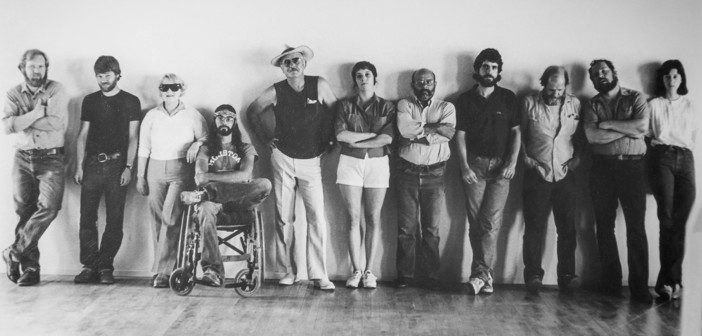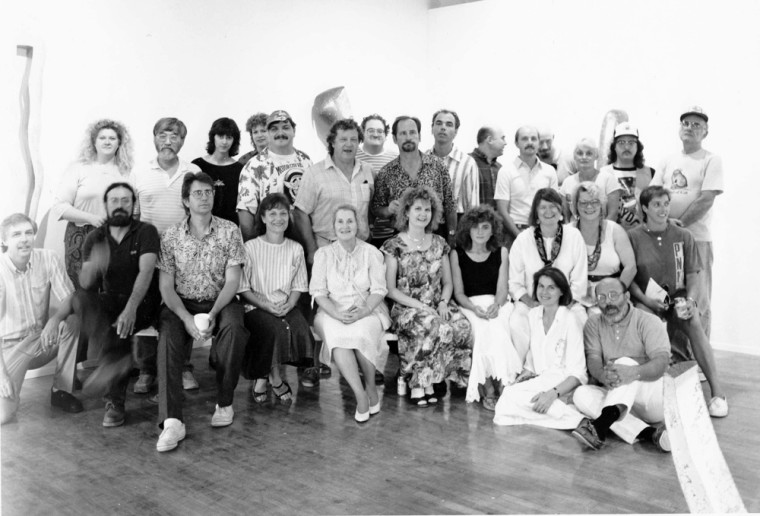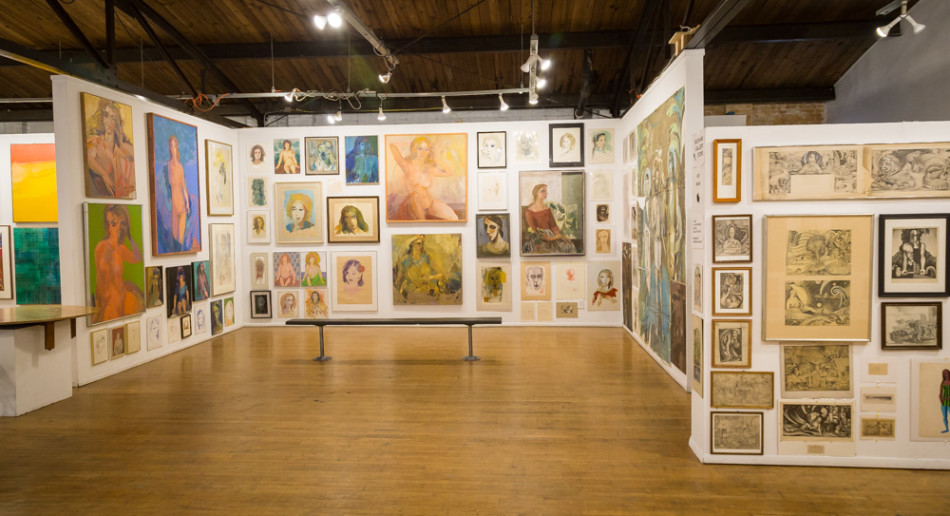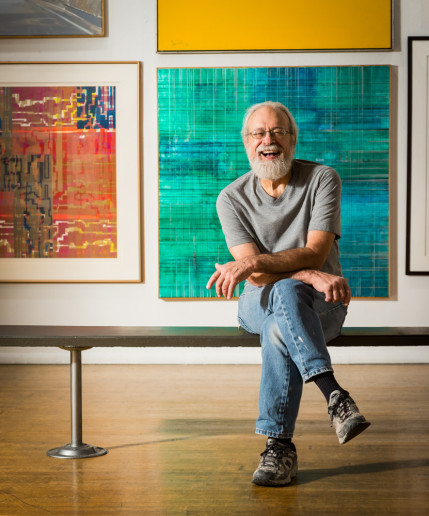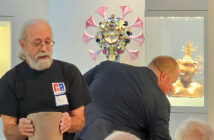Moving through the narrow staircase leading up to 134 ½ West Second Street – home to Buckham Gallery for the past 30 years – carries excitement and anticipation. Hearing the chatter of guests above and their feet on the creaking wood floors before you reach the top; before the narrow way opens into a large, carefully-lit space where white walls bear contemporary art. The vibrancy of the space is balanced with the contrasting heavy, dark wood beams of the cathedral ceiling.
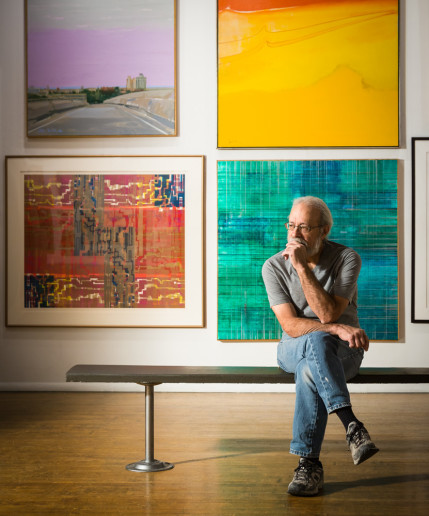 The space was renovated by the hands of the founding artists. Bill Chatterson recalled in a documentary made by founding member John Kotarski, “there was a drop ceiling suspended from the tresses … and we had to get rid of it. I mean, the ceiling is so beautiful. You had to have that exposed, that was one of the first things. It was an incredibly laborious and dirty job and it was perfect for an 18 or 19-year-old kid,” Chatterson continues, “it was real methodical and dirty, but once we got it open, it was well worth it.” He adds, “it’s one of the best spaces in Michigan for exhibiting.”
The space was renovated by the hands of the founding artists. Bill Chatterson recalled in a documentary made by founding member John Kotarski, “there was a drop ceiling suspended from the tresses … and we had to get rid of it. I mean, the ceiling is so beautiful. You had to have that exposed, that was one of the first things. It was an incredibly laborious and dirty job and it was perfect for an 18 or 19-year-old kid,” Chatterson continues, “it was real methodical and dirty, but once we got it open, it was well worth it.” He adds, “it’s one of the best spaces in Michigan for exhibiting.”
Since it opened in the spring of 1984, the Buckham Fine Arts Project has been the place where many local artists, writers and musicians have experienced, and been part of, Downtown Flint’s culture of creativity.
There is no previously written history of Buckham Gallery. Within a few boxes of artifacts containing the original handwritten plans, a typed proposal and articles of incorporation, and a collection of flyers from shows and events, the history of Buckham’s founding and first 30 years is largely in the memories of those involved. Many of the founders have passed away, making an attempt at recognizing the history of the Gallery even more important.
It is fitting, in these last winter days, to recall a few words from Richard Wilbur’s Year’s End; “These sudden ends of time must give us pause.” As Buckham prepares for its first move in three decades, we take a look back on where Buckham Fine Arts Project originated and some of the artists who were a part of it, and appreciate a little of what the Gallery has meant to Flint.
A Look Back
Originally owned by Gary Gebhardt, the entire building was a creative space, housing The Torch, Buckham Alley Theatre and several artist studios – part of a thriving artist community in Buckham Alley. Buckham Alley Theatre was downstairs, while several artists including Doug Warner, Gary Gebhart, and Sally Strand had their studios in the building, as well. The Torch, which still stands as a Flint-favorite restaurant, was conveniently located in the middle of the building – a comfortable gathering place for the Alley residents. According to long-time Flint artist, FIA art school instructor and master potter, Guy Adamec, “It was a great little art community, in this alley. I think that was definitely part of the energy, it was fun to be a part of.”
Buckham Fine Arts Project grew largely from a group of friends who taught in the art program at Mott Community College (MCC), which many early members say was one of the best studio art departments in the state. “Mott Community College, of all places,” Adamec says. “Students could get a degree from MCC and then get into any other place.” It was through the connection with MCC that this group of teaching artists concluded that Flint needed a contemporary gallery ran by artists.
Flint Institute of Arts, in the Cultural Center, served as the community art museum with well-established artists from around the world. What Flint lacked was a gallery focused on local, contemporary art, that could respond to and change with the shifting time. Two examples of Buckham’s ability to acknowledge current events include a special exhibition, “China June 4, 1989 An Art Exhibit,” created by a group of Chinese artists in response to the Tiananmen Square massacre of 1989. More recently, Buckham held an exhibit on the Flint Water Crisis. These are shows that wouldn’t have a space Downtown if the early Buckham founders and supporters hadn’t followed through. The founding members created the place to show their art locally, and to support art in the city as, “an exciting part of the renaissance taking place in Downtown Flint today,” as written in their early call for members.
“It was just a place for exposure, just a place to show.”
GUY ADAMEC
“Tom Nuzum, Bob Caskey and Sam Morello were probably the driving forces,” Adamec states. He calls the decision a, “logical extension” for the group. When Gebhardt offered them the upstairs space, plans transformed into action. The handwritten documents from the files at Buckham record the first meeting date as March 16, 1984, held in Linda Rose’s studio on Buckham’s ground floor. Opening day was a short two months later in May. Current artist member, Shelley Spivack, was the original attorney for Buckham and completed the incorporation and 501(C)(3) application. “My payment was my choice of artwork!” she exclaims. She chose a print by Nancy Toth, that still hangs on her wall today.
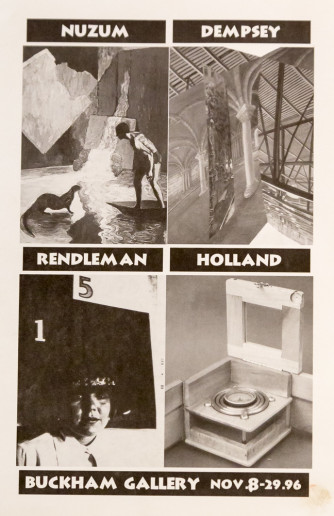 The Articles of Incorporation listed the names of the “three incorporators” as Thomas William Nuzum, Kathleen Rene Rose and Robert Caskey. One purpose of Buckham was set, “to actively encourage artists who are making unique and significant statements in their chosen disciplines by providing an exciting environment in which to display or perform their work.” Thirty years of countless shows and exhibits at Buckham Gallery have impacted those artists, as well as the community that enjoys their works.
The Articles of Incorporation listed the names of the “three incorporators” as Thomas William Nuzum, Kathleen Rene Rose and Robert Caskey. One purpose of Buckham was set, “to actively encourage artists who are making unique and significant statements in their chosen disciplines by providing an exciting environment in which to display or perform their work.” Thirty years of countless shows and exhibits at Buckham Gallery have impacted those artists, as well as the community that enjoys their works.
An important point for Buckham’s originators was that the gallery was not for selling art, Adamec explains. “It was just a place for exposure, just a place to show. And you showed what you liked, not what you thought would sell – which is different. That freed us up. It was better quality art, because we were doing work that we felt strongly about, not something that was just for money.” He asserts, “this place was the people making art – that’s where the energy was. Which is why it was cool, and that’s why it stays. This is where the more interesting work is, even if it’s not popular.”
“All of the gallery founders were phenomenal artists
– true, talented artists.”
MICHAEL MELET
The value of a gallery run by artists is echoed in the sentiment and drive of its members, and in the persistence in each year the gallery has survived. “A place like this lasting is not only uncommon, it is extremely rare,” insists founding member, Sam Morello. Artists groups and galleries often open and then close in a few months. Although Buckham certainly had its struggles, including almost closing for lack of funds, early efforts at fundraising included: cocktail parties, members raffling their artwork, benefit concerts and old-fashioned rent parties, along with applying for community grants. But, much of the diligence it takes to maintain a gallery like Buckham is completely reliant on member volunteer hours.
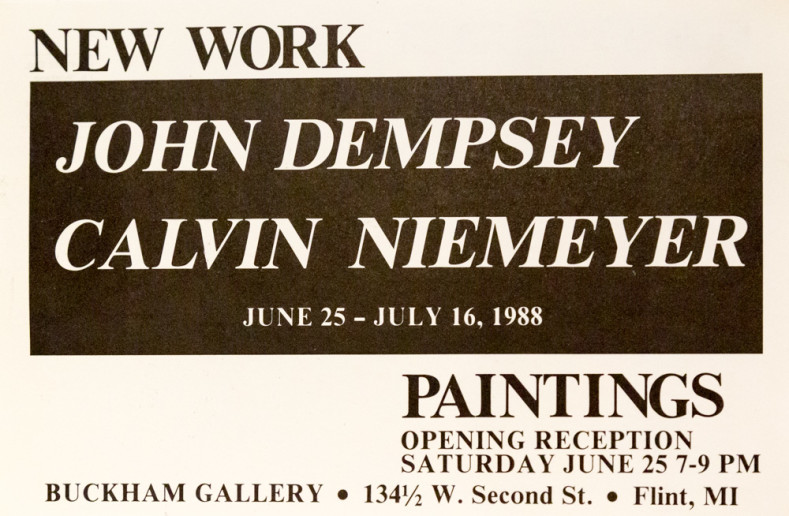 An active member commits their time to a choice of committees that have tasks such as hanging artwork for shows, or handling the finances needed to maintain operations. Joe Matuzak, one of the gallery’s first executive directors, explains, “originally, when an organization like Buckham comes together, there is a great pooling of energy, and that is how it was … and that initial energy can begin to wane.” But, it was day-to-day tasks that drained the artists. That was when the committees were formed and positions created, such as executive director, to take the burden from the artists.
An active member commits their time to a choice of committees that have tasks such as hanging artwork for shows, or handling the finances needed to maintain operations. Joe Matuzak, one of the gallery’s first executive directors, explains, “originally, when an organization like Buckham comes together, there is a great pooling of energy, and that is how it was … and that initial energy can begin to wane.” But, it was day-to-day tasks that drained the artists. That was when the committees were formed and positions created, such as executive director, to take the burden from the artists.
The First Show at Buckham Gallery
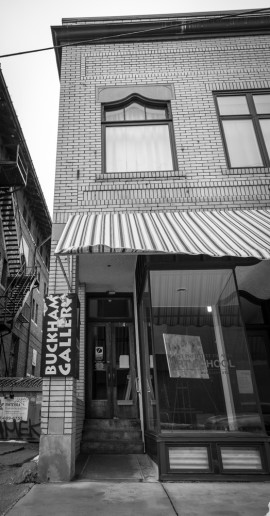 The first exhibition was titled “Enclaves,” and featured installation sculpture by several Michigan artists including Robert Caskey of MCC; Syd Atkinson of Flint; and Jay Yeager, an installation artist then teaching at Eastern Michigan University.
The first exhibition was titled “Enclaves,” and featured installation sculpture by several Michigan artists including Robert Caskey of MCC; Syd Atkinson of Flint; and Jay Yeager, an installation artist then teaching at Eastern Michigan University.
As a testament to what art can do for the individual; Bob Caskey, who participated in the first show, created a piece inspired by The Circular Ruins by Jorge Luis Borges, a short story of a man who sets out to dream a man to life. Caskey explained that he had a revelation through his artistic process. “The act of making art is an act of self-creation … my task is to dream the art piece alive, and myself in the process.” Caskey recalled that first Buckham show experience was one that changed his outlook, and his future artwork. A testament to what art can do for the individual and the larger community, Buckham has been a force in Downtown Flint, dreaming the art scene alive for over 30 years and adding new members every year.
Buckham’s impact through the eyes of a few of those involved
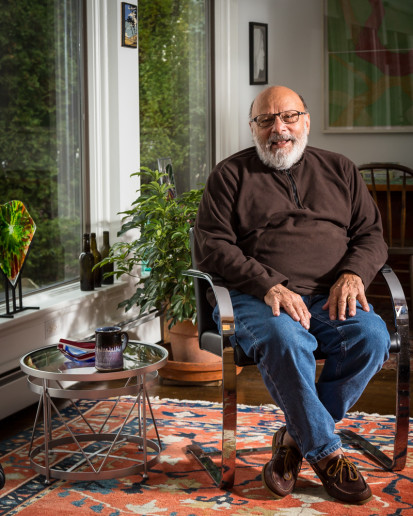 Sam Morello, Founding Member
Sam Morello, Founding Member
Over 50 years ago, Morello arrived in the Flint area after finishing his Masters of Fine Arts at University of Michigan Ann Arbor, and came to teach in Mott Community College’s art department. “Flint was what a lot of us feared it was – a factory town, with not much in the way of an art scene,” he shares. “About every artist we knew thought that could change, and we all felt like we needed to do what artists do: make art. Most of us who came from elsewhere were looking for a gallery that would display our work.”
Morello remembers MCC as, “a small art department of about four or five people.” He asserts, “we were a part of Flint staying alive. It’s safe to say that the original people really wanted it and there were enough people in Flint who were not artists who really wanted it. There were enough people, and a lucky moment of chemistry and energy.”
Morello not only enjoyed all of the shows over the years, whether he liked the artwork or not; but Buckham also maintained what he calls, “a reason to do something with my art.” As a busy professor and head of the MCC department which includes art, music and theatre, he says, “Buckham didn’t demand a total commitment of one’s life; but, I think it’s been an energy and a force.”
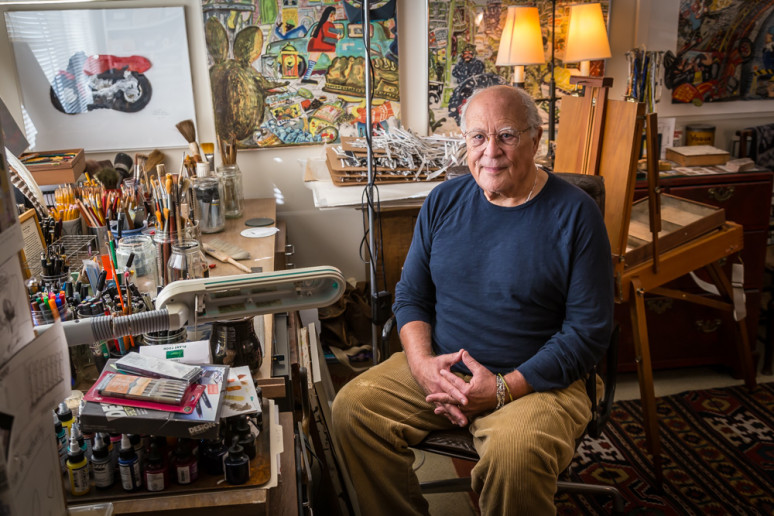 Michael Melet
Michael Melet
A part of Downtown Flint his entire life, Melet’s family owned a women’s fashion business Downtown before GM pulled out of Flint. He’s been on “so many boards in Flint, anything you can think of … and then some.” Around 20 years ago, Sam Morello asked him to sit on the board for Buckham. “I went to the first meeting and they were taking minutes on a napkin with a pencil,” Melet says. The treasurer’s report took about 30 seconds, and I’m thinking, ‘oh man, what did I get myself into?’” He emphasizes, “All of the gallery founders were phenomenal artists – true, talented artists.”
Melet’s personal experience with Buckham is one example of the inspiration generations of artists around Flint have experienced. He says he never thought of himself as an artist, yet, when someone at Buckham heard that he had been sketching his whole life, they asked him to bring work in. “I brought in a sketchpad in the fall of 2010, and they asked me to be in their 2011 February show.”
“Being in a show anywhere never entered my mind – but I knew from living in Flint my whole life that there’s no gallery like the Buckham Gallery, as far as talent is concerned,” Melet emphasizes. “The night of the opening in February was the first night in my life that my artwork was up on the walls, and the young people didn’t know who I was and I was able to walk around scared to death of what I was going to hear. Their unsolicited, uncensored comments just blew me away. And for the first time, I was thinking, ‘Michael, I guess you have some talent.’”
After Melet began actively participating in shows, he began to look differently at making art. “I started doing things that I probably would never have done,” he says. Some of his pieces on the villas in Montauk were made using layers of glass with watercolor and photos, work he attributes to allowing new inspiration to push him into different terrain, which was directly motivated by the opportunity to show his work at Buckham.
For Melet, what makes Buckham memorable is, “the diversity of the art, year after year, month after month, you never see the same thing. It’s been show after show of great imaginations coming up with some great ideas, executed beautifully.” Melet continues, “I spend a lot of time in New York and visit the galleries there and I am blown away by the talent we have right here in Michigan, right here at Buckham in Flint.”
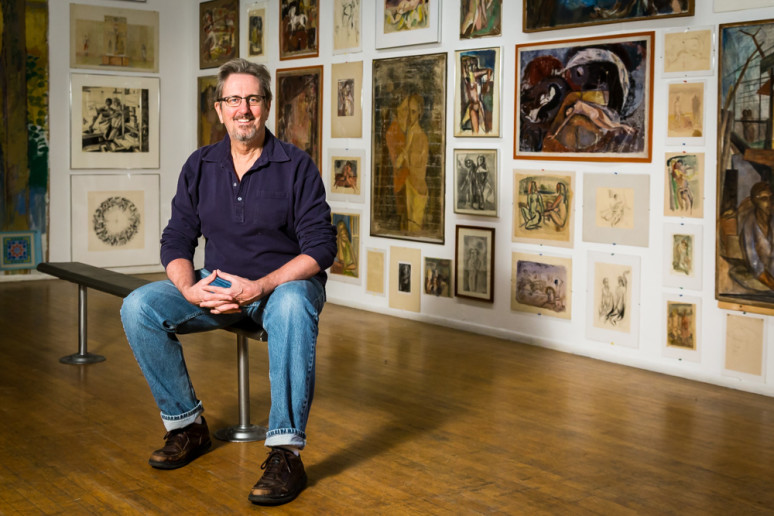 John Dempsey
John Dempsey
An artist member who joined around 1986, Dempsey has stayed active as a past board member, past president and past treasurer, among other roles, and his studio remains in the front of the gallery building. Brought to Flint as an art writer for the New Art Examiner, he was drawn in by the dynamic of Flint’s art scene. “I came to Flint and there was more energy here, I felt more empathetic with it, more attracted to it, so I ended up gravitating here. Most of my reviews were about shows here because they were more interesting … and then, when Tom Nuzum and Sam Morello asked me to join, I just kind of left writing and started working as an artist.”
One memorable Buckham show included a visit from writer/poet, Allen Ginsberg. “He was invited and he came and did a reading here,” Dempsey recalls. “In fact, as the story goes, the fire marshal came in and wanted to shut it down because there were so many people crammed into the space.”
Dempsey adds, “It was the kind of place in Downtown where you could come and do ‘art types of things’ and nobody would tell you that you couldn’t.”
Influencing New Artist Members
 Janice McCoy
Janice McCoy
One of the most recently accepted members, McCoy is finishing her degree in art education and general studio art at the University of Michigan-Flint. She began as a biology major, and first heard about Buckham Gallery from taking Art 100 with Tim Kranz, an artist member who has a studio downstairs in the Buckham building. “As I changed my major and transitioned more into art, I noticed that most of the UM-Flint faculty were involved with Buckham in some capacity. That was about four years ago, and ever since, I’ve really wanted to be a member.” In 2017 she applied, and much to her excitement, was accepted as a member.
Along with finding out about Buckham, McCoy heard of ArtWalk, an event that takes place on the second Friday of every month, which includes shows at Buckham Gallery and several other Downtown venues. “I usually go to Buckham every month and I always see people I know, and everyone is really happy to see each other. So, besides the fact that it is professionally good to be associated with a gallery, I really enjoy pretty much everyone who is involved or works there.”
Although the large group of members rarely meets all at once, many of the original members are still connected. Guy Adamec, who has shown at Buckham every two or three years since the late 80s, says, “I visit friends and they have pieces of mine in their homes.” And, in fact, the connection of these early members to each other’s work is evident in their own homes. At Founder Sam Morello’s, for example, Guy Adamec’s ceramic mugs are used for coffee and the artwork on the walls includes pieces by local artist, Doug Warner.
“The environment Downtown arose mainly because of Buckham being there and being successful.”
SAM MORELLO
The End of an Era
But, something is changing for Buckham Gallery. Those narrow stairs that early members once carried artist member, Ken Kenyon up, along with his wheelchair, have been a struggle and a barrier for some. “An elevator is restrictively out of our price range,” says Adamec. Without other options, and with the votes of the newer members, the entity that once fostered an entire artist community in Downtown Flint, is now leaving that location. The Board is working with Buckham’s funders to find a new, barrier-free location.
According to Morello, at the time Buckham started, “nobody wanted to go to Downtown Flint – there was really nothing there – and now, everyone wants to be Downtown Flint.” Which is part of the reason they are having difficulty finding an affordable space as usable as Buckham Gallery. Morello believes that Buckham’s lasting success helped bring people Downtown. “The environment Downtown arose mainly because of Buckham being there and being successful. I think a lot of organizations have thought, ‘if they’re still here after 30 years, maybe we could open something and be there, too.’ So, the good spots for us, on the ground floor, are all gone.”
For Buckham, the move to a new location seems to signify the end of an era. But, the City of Flint has a vibrant art scene, perhaps only beginning to show its place in Flint’s resurgence. As new members are added every year, perhaps now is the opportunity to start anew, revitalized, and push into the next era with a similar energy that started Buckham back in 1984. If, according to Adamec, “the artists are where the energy is,” The Buckham Gallery Art Project might just be gaining momentum.
Photography by Eric Dutro
Photos Provided by Buckham Fine Arts Project

